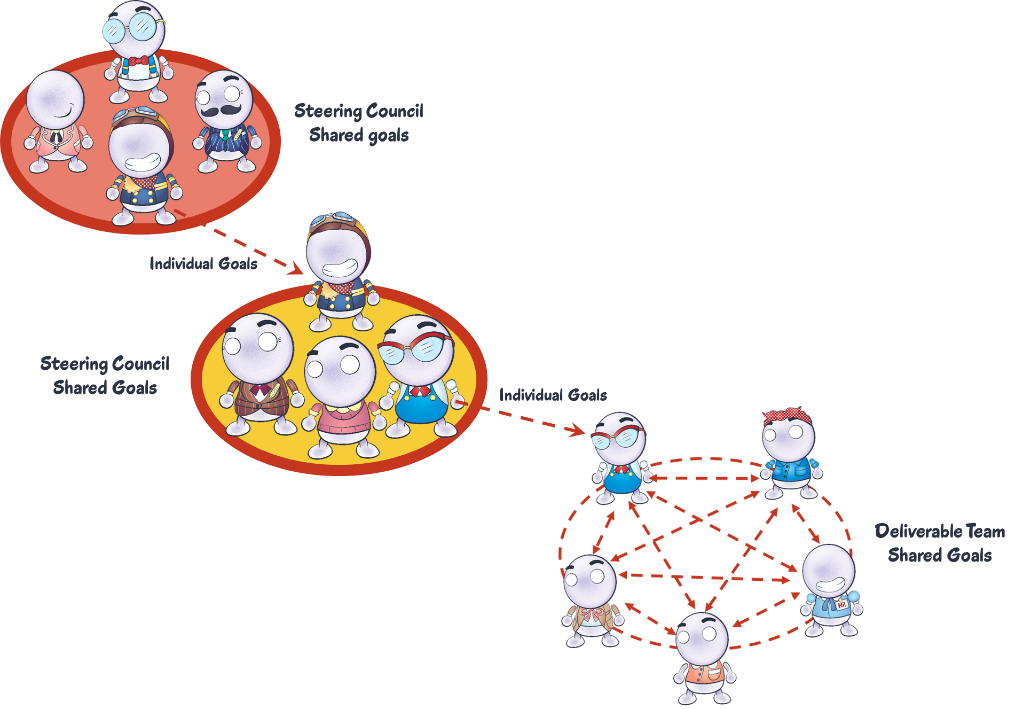Matrix Management Wiki
Home » The Structure Key » 3M. Matrix Management 2.0 Goal Definition/Decomposition
- 3M1. The strategic intent is the organization’s vision for its future.
- 3M1i. The strategic intent is usually created by the leadership team and is owned by the Executive Steering Council.
- 3M2. The strategic plan maps out:
- 3M2i. How the organization will achieve its strategic intent.
- 3M2ii. Goals for each of the segments are defined. These goals represent the changes that need to occur in order for the organization to move forward. This is called the strategic plan.
- 3M2iii. Strategic goals are then decomposed into concrete, tangible outputs called deliverables. This decomposition usually happens at the Operational Steering Council level.
- 3M2iv. Goals cannot be directly executed. They must first be decomposed into deliverables, which are produced by projects.
- 3M2iva. Internally focused deliverables are produced by vector projects.
- 3M2ivb. Externally focused deliverables (business deliverables) are produced as sector projects.
- 3M2v. Ongoing deliverables are produced by business processes or operating projects.
- 3M3. Validation of the strategic plan:
- 3M3i. The strategic plan is verified by answering the following questions in the affirmative: Do the portfolios of initiatives/projects add up to a successful plan? Can each project be linked to a strategic goal? Does each strategic goal have at least one or more initiatives/projects associated with it that, if accomplished, would achieve that goal?
- 3M3ii. The next step of validation is to ensure that there are resources available to accomplish the initiatives/projects. If the resource capacity falls short, then one of two things can be done:
- 3M3iia. Projects are not selected or placed on hold and the corresponding goals are removed from the plan, or
- 3M3iib. More resources are added to the resource pool.
- 3M4. Rules for MM 2.0 goal decomposition:
- 3M4i. Goals are decomposed horizontally, through horizontal governance teams (Steering Councils).
- 3M4ii. Goals are decomposed down to the level of deliverables.
- 3M4iii. Goals and deliverables are owned by individuals and shared by teams.
- 3M4iv. Goals must be achievable.
- 3M4v. Individuals have a portfolio of goals and deliverables that is added to, and changed, as the year progresses.
- 3M5. Steering Councils have shared goals.
- 3M5i. The sharing of goals forces everyone on the Steering Council to work together.
- 3M5ii. Figure 3.7. Diagram of shared goals.

- 3M6. Goal deployment:
- 3M6i. After the goals are negotiated and agreed to by a Steering Council, they are then decomposed into more specific goals and assigned to individuals on the council.
- 3M6ii. These are then deployed to a next level of steering, operational steering (if the organization is large enough to warrant more than one level of steering) and shared by that group. The goals are then decomposed into deliverables and deployed to the deliverables team level.
- 3M6iii. The individual on the Steering Council retains accountability for the goals. The deliverables team (such as a project team) assumes accountability for the specific deliverables to be produced.

